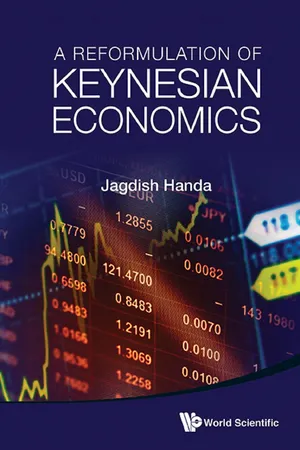Economics
Financial Economics
Financial economics is a branch of economics that focuses on the allocation of resources over time under uncertainty. It combines economic theory with quantitative methods to analyze financial markets, investments, and the pricing of assets. This field explores how individuals, businesses, and governments make decisions about allocating resources in the presence of risk and uncertainty.
Written by Perlego with AI-assistance
Related key terms
3 Key excerpts on "Financial Economics"
- eBook - ePub
- Jagdish Handa(Author)
- 2015(Publication Date)
- WSPC(Publisher)
This chapter addresses the reformulation of macroeconomics for a ‘financial economy’ to bring financial capital into its analysis. A barter economy is one in which economic agents do not need money as a medium of payments, nor do they need financial capital to fund their operations. A “monetary economy” differs from the barter one in that it requires that the exchanges of commodities financial instruments and labor be against money but not directly against other commodities, financial instruments or labor. Money in the medium of payments in such an economy; however, economic agents in such an economy do not necessarily need financial capital to produce or consume. A financial economy goes beyond a monetary economy in requiring that its economic agents must have the financial resources/capital (in addition to merely having money balances for exchanges) to fund their operations, such as, for firms, to purchase and hold physical capital and pay labor or, for consumers, to buy and hold consumer goods (including housing). We consider the modern economy to be a financial one.The amount of money held by the economic agent can be regarded as one element of the broad definition of financial capital. However, the role of money as facilitating exchanges with others is quite different from that of the financial capital, which is needed by firms and households to produce or consume. Since the role of money is a very distinctive one, we will treat money as distinct from financial capital. However, we define the financial economy as encompassing a monetary one but going beyond a monetary economy by requiring the use of financial capital.Financial capital differs from physical capital, with the former having a nominal form (i.e., in currency units) while the latter has a physical one. To stay with the usual terminology of economics, we will leave the word “capital” to continue to have its usual meaning as physical capital. We will often use the word “funds” as a short form for financial capital.Firms need financial capital to bridge the gap between the time when they incur costs and receive revenues from sales. A major part, though not all of it, of the need for financial capital arises from the firm’s use of physical capital, parts of which have a long life. For firms, while the need for working finance can be reduced by leasing the required physical capital rather than its outright purchase, in practice, most capital equipment is owned outright rather than leased.2 - eBook - ePub
- Indranarain Ramlall(Author)
- 2018(Publication Date)
- Emerald Publishing Limited(Publisher)
While writing this book, rigorous and comprehensive steps have been taken to ensure that all aspects of financial stability are being covered. The author got an interesting surprise. As at date, financial stability is merely defined as a state of affair which relates the financial system to the real economy. This appears intriguing bearing in mind the significance of financial stability in the whole world. This can best be explained by using an analogy based on the experience of the author in the field of econometrics. Gujarati (2011) defines econometrics as a subject which incorporates mathematics, economics and statistics. Based on this, the author considers that it is high time that financial stability becomes a subject area of its own. To the author, financial stability, as a field on its own, can be defined as a subject which incorporates economics, finance and econometrics. Econometrics is incorporated because many analytical tools are widely used to gauge on financial stability risks such as stress testing and vector autoregressive models. With the upcoming up FinTech, financial stability can now be considered as a field which incorporates economics, finance, econometrics and technology.A priori, it may appear surprising but the truth is that everything in economics and finance is related to financial stability. Table 2.1 attests to such a relationship.Table 2.1: Disentangling the Relationship between Economics and Finance and Financial Stability.Economics and Finance-embedded Theories/Areas of Focus Interpretation from Financial Stability Perspective Schools of thoughts in economics Political economy Capital structure and dividend policy of firms Corporate sector financial stability and information asymmetry problems Efficiency market hypothesis/capital asset pricing models Asset price bubbles – fundamental values Exchange rates arrangements External price competitiveness Market structures Ability to make profits to survive Demographic analysis Household and real estate sectors Game theory Regulation of firms Monetarism Monetary policy à la Taylor rule Rational expectations Gauging on market behaviour – credibility in policies (monetary and financial stability policies) Behavioural finance Animal spirits and asset price bubbles Central Bank Independence Political economy Fractional Reserve Banking - (Author)
- 2019(Publication Date)
- Wiley(Publisher)
describe how economic analysis is used in sector rotation strategies;- describe the economic factors affecting investment in commercial real estate.
1 . Introduction
The state of the economy and financial market activity are interconnected. Financial markets are the forums where savers are connected with investors. This activity enables savers to defer consumption today for consumption in the future, allows governments to raise the capital necessary to create a secure society, and permits corporations to access capital to exploit profitable investment opportunities, which, in turn, should help to generate future economic growth and employment. Furthermore, all financial instruments essentially represent claims on an underlying economy. There is, therefore, an important and fundamental connection that runs from the decisions of economic agents, as they plan their present and future consumption, to the prices of financial instruments such as bonds and equities.The purpose of this reading is to identify and explain the links between the real economy and financial markets and to show how economic analysis can be used to develop ways of valuing both individual financial market securities and aggregations of these securities, such as financial market indexes. We begin by reviewing what we refer to as the fundamental pricing equation for all financial instruments. Using this framework, we then move on to explore the relationship between the economy and real default-free debt. From there, we can extend the analysis to the ways in which the economy can influence the prices of the following: nominal default-free debt; credit risky debt (for example, corporate bonds); publicly traded equities; and commercial real estate.2 . Framework for the Economic Analysis of Financial Markets
The reference point for the analysis of this reading is the present value model of asset valuation. The impact of economic factors on asset values can be studied in the context of that model by examining how economic factors can affect discount rates and future cash flows. These topics are explored in more detail in the following sections.
Learn about this page
Index pages curate the most relevant extracts from our library of academic textbooks. They’ve been created using an in-house natural language model (NLM), each adding context and meaning to key research topics.


